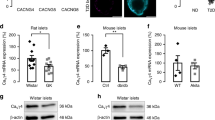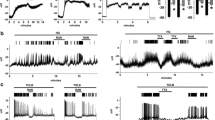Abstract
The voltage-gated Ca2+ (CaV) channel acts as a key player in β cell physiology and pathophysiology. β cell CaV channels undergo hyperactivation subsequent to exposure to type 1 diabetic (T1D) serum resulting in increased cytosolic free Ca2+ concentration and thereby Ca2+-triggered β cell apoptosis. The present study was aimed at revealing the subtypes of CaV1 channels hyperactivated by T1D serum as well as the biophysical mechanisms responsible for T1D serum-induced hyperactivation of β cell CaV1 channels. Patch-clamp recordings and single-cell RT-PCR analysis were performed in pancreatic β cells from CaV1 channel knockout and corresponding control mice. We now show that functional CaV1.3 channels are expressed in a subgroup of islet β cells from CaV1.2 knockout mice (CaV1.2−/−). T1D serum enhanced whole-cell CaV currents in islet β cells from CaV1.3 knockout mice (CaV1.3−/−). T1D serum increased the open probability and number of functional unitary CaV1 channels in CaV1.2−/− and CaV1.3−/− β cells. These data demonstrate that T1D serum hyperactivates both CaV1.2 and CaV1.3 channels by increasing their conductivity and number. These findings suggest CaV1.2 and CaV1.3 channels as potential targets for anti-diabetes therapy.




Similar content being viewed by others
Abbreviations
- CaV :
-
Voltage-gated calcium
- CaV1.2−/− :
-
CaV1.2 subunit knockout
- CaV1.3−/− :
-
CaV1.3 subunit knockout
- DHP:
-
Dihydropyridine
- T1D:
-
Type 1 diabetic
References
Yang SN, Berggren PO (2005) β-Cell CaV channel regulation in physiology and pathophysiology. Am J Physiol 288:E16–E28
Yang SN, Berggren PO (2006) The role of voltage-gated calcium channels in pancreatic β-cell physiology and pathophysiology. Endocr Rev 27:621–676
Trus M, Corkey RF, Nesher R, Richard AM, Deeney JT, Corkey BE, Atlas D (2007) The L-type voltage-gated Ca2+ channel is the Ca2+ sensor protein of stimulus–secretion coupling in pancreatic beta cells. Biochemistry 46:14461–14467
Berggren PO, Yang SN, Murakami M, Efanov AM, Uhles S, Kohler M, Moede T, Fernstrom A, Appelskog IB, Aspinwall CA, Zaitsev SV, Larsson O, Moitoso de Vargas L, Fecher-Trost C, Weissgerber P, Ludwig A, Leibiger B, Juntti-Berggren L, Barker CJ, Gromada J, Freichel M, Leibiger IB, Flockerzi V (2004) Removal of Ca2+ channel β3 subunit enhances Ca2+ oscillation frequency and insulin exocytosis. Cell 119:273–284
Yang SN, Shi Y, Yang G, Li Y, Yu J, Berggren PO (2014) Ionic mechanisms in pancreatic β cell signaling. Cell Mol Life Sci. [Epub ahead of print]
Braun M, Ramracheya R, Bengtsson M, Zhang Q, Karanauskaite J, Partridge C, Johnson PR, Rorsman P (2008) Voltage-gated ion channels in human pancreatic β-cells: electrophysiological characterization and role in insulin secretion. Diabetes 57:1618–1628
Iwashima Y, Pugh W, Depaoli AM, Takeda J, Seino S, Bell GI, Polonsky KS (1993) Expression of calcium channel mRNAs in rat pancreatic islets and downregulation after glucose infusion. Diabetes 42:948–955
Schulla V, Renstrom E, Feil R, Feil S, Franklin I, Gjinovci A, Jing XJ, Laux D, Lundquist I, Magnuson MA, Obermuller S, Olofsson CS, Salehi A, Wendt A, Klugbauer N, Wollheim CB, Rorsman P, Hofmann F (2003) Impaired insulin secretion and glucose tolerance in β cell-selective CaV1.2 Ca2+ channel null mice. Embo J 22:3844–3854
Sinnegger-Brauns MJ, Hetzenauer A, Huber IG, Renstrom E, Wietzorrek G, Berjukov S, Cavalli M, Walter D, Koschak A, Waldschutz R, Hering S, Bova S, Rorsman P, Pongs O, Singewald N, Striessnig JJ (2004) Isoform-specific regulation of mood behavior and pancreatic β cell and cardiovascular function by L-type Ca2+ channels. J Clin Invest 113:1430–1439
Engel J, Michna M, Platzer J, Striessnig J (2002) Calcium channels in mouse hair cells: function, properties and pharmacology. Adv Otorhinolaryngol 59:35–41
Yang SN, Larsson O, Branstrom R, Bertorello AM, Leibiger B, Leibiger IB, Moede T, Kohler M, Meister B, Berggren PO (1999) Syntaxin 1 interacts with the LD subtype of voltage-gated Ca2+ channels in pancreatic β cells. Proc Natl Acad Sci USA 96:10164–10169
Namkung Y, Skrypnyk N, Jeong MJ, Lee T, Lee MS, Kim HL, Chin H, Suh PG, Kim SS, Shin HS (2001) Requirement for the L-type Ca2+ channel α1D subunit in postnatal pancreatic β cell generation. J Clin Invest 108:1015–1022
Vignali S, Leiss V, Karl R, Hofmann F, Welling A (2006) Characterization of voltage-dependent sodium and calcium channels in mouse pancreatic A- and B-cells. J Physiol 572:691–706
Lee AK, Yeung-Yam-Wah V, Tse FW, Tse A (2011) Cholesterol elevation impairs glucose-stimulated Ca2+ signaling in mouse pancreatic β-cells. Endocrinology 152:3351–3361
Roe MW, Worley JF, Tokuyama Y, Philipson LH, Sturis J, Tang J, Dukes ID, Bell GI, Polonsky KS (1996) NIDDM is associated with loss of pancreatic β-cell L-type Ca2+ channel activity. Am J Physiol 270:E133–E140
Yamada Y, Kuroe A, Li Q, Someya Y, Kubota A, Ihara Y, Tsuura Y, Seino Y (2001) Genomic variation in pancreatic ion channel genes in Japanese type 2 diabetic patients. Diabetes Metab Res Rev 17:213–216
Yamada Y, Masuda K, Li Q, Ihara Y, Kubota A, Miura T, Nakamura K, Fujii Y, Seino S, Seino Y (1995) The structures of the human calcium channel α1 subunit (CACNL1A2) and β subunit (CACNLB3) genes. Genomics 27:312–319
Splawski I, Timothy KW, Sharpe LM, Decher N, Kumar P, Bloise R, Napolitano C, Schwartz PJ, Joseph RM, Condouris K, Tager-Flusberg H, Priori SG, Sanguinetti MC, Keating MT (2004) CaV1.2 calcium channel dysfunction causes a multisystem disorder including arrhythmia and autism. Cell 119:19–31
Juntti-Berggren L, Larsson O, Rorsman P, Ammala C, Bokvist K, Wahlander K, Nicotera P, Dypbukt J, Orrenius S, Hallberg A, Berggren PO (1993) Increased activity of L-type Ca2+ channels exposed to serum from patients with type I diabetes. Science 261:86–90
Juntti-Berggren L, Refai E, Appelskog I, Andersson M, Imreh G, Dekki N, Uhles S, Yu L, Griffiths WJ, Zaitsev S, Leibiger I, Yang SN, Olivecrona G, Jornvall H, Berggren PO (2004) Apolipoprotein CIII promotes Ca2+-dependent β cell death in type 1 diabetes. Proc Natl Acad Sci USA 101:10090–10094
Shi Y, Yang G, Yu J, Yu L, Westenbroek R, Catterall WA, Juntti-Berggren L, Berggren PO, Yang SN (2014) Apolipoprotein CIII hyperactivates β cell CaV1 channels through SR-BI/β1 integrin-dependent coactivation of PKA and Src. Cell Mol Life Sci 71:1289–1303
Platzer J, Engel J, Schrott-Fischer A, Stephan K, Bova S, Chen H, Zheng H, Striessnig J (2000) Congenital deafness and sinoatrial node dysfunction in mice lacking class D L-type Ca2+ channels. Cell 102:89–97
Yang SN, Wenna ND, Yu J, Yang G, Qiu H, Yu L, Juntti-Berggren L, Kohler M, Berggren PO (2007) Glucose recruits KATP channels via non-insulin-containing dense-core granules. Cell Metab 6:217–228
Refai E, Dekki N, Yang SN, Imreh G, Cabrera O, Yu L, Yang G, Norgren S, Rossner SM, Inverardi L, Ricordi C, Olivecrona G, Andersson M, Jornvall H, Berggren PO, Juntti-Berggren L (2005) Transthyretin constitutes a functional component in pancreatic β-cell stimulus–secretion coupling. Proc Natl Acad Sci USA 102:17020–17025
Zhang W, Efanov A, Yang SN, Fried G, Kolare S, Brown H, Zaitsev S, Berggren PO, Meister B (2000) Munc-18 associates with syntaxin and serves as a negative regulator of exocytosis in the pancreatic β-cell. J Biol Chem 275:41521–41527
Yu J, Leibiger B, Yang SN, Caffery JJ, Shears SB, Leibiger IB, Barker CJ, Berggren PO (2003) Cytosolic multiple inositol polyphosphate phosphatase in the regulation of cytoplasmic free Ca2+ concentration. J Biol Chem 278:46210–46218
Brown H, Larsson O, Branstrom R, Yang SN, Leibiger B, Leibiger I, Fried G, Moede T, Deeney JT, Brown GR, Jacobsson G, Rhodes CJ, Braun JEA, Scheller RH, Corkey BE, Berggren PO, Meister B (1998) Cysteine string protein (CSP) is an insulin secretory granule-associated protein regulating β-cell exocytosis. Embo J 17:5048–5058
Brown H, Meister B, Deeney J, Corkey BE, Yang SN, Larsson O, Rhodes CJ, Seino S, Berggren PO, Fried G (2000) Synaptotagmin III isoform is compartmentalized in pancreatic β-cells and has a functional role in exocytosis. Diabetes 49:383–391
Barg S, Eliasson L, Renstrom E, Rorsman P (2002) A subset of 50 secretory granules in close contact with L-type Ca2+ channels accounts for first-phase insulin secretion in mouse β-cells. Diabetes 51:S74–S82
Koschak A, Reimer D, Huber I, Grabner M, Glossmann H, Engel J, Striessnig J (2001) α1D (CaV1.3) Subunits can form L-type Ca2+ channels activating at negative voltages. J Biol Chem 276:22100–22106
Xu W, Lipscombe D (2001) Neuronal CaV1.3α1 L-type channels activate at relatively hyperpolarized membrane potentials and are incompletely inhibited by dihydropyridines. J Neurosci 21:5944–5951
Seino S, Chen L, Seino M, Blondel O, Takeda J, Johnson JH, Bell GI (1992) Cloning of the α1 subunit of a voltage-dependent calcium channel expressed in pancreatic β cells. Proc Natl Acad Sci USA 89:584–588
Herold KC, Vignali DA, Cooke A, Bluestone JA (2013) Type 1 diabetes: translating mechanistic observations into effective clinical outcomes. Nat Rev Immunol 13:243–256
Aguayo-Mazzucato C, Bonner-Weir S (2010) Stem cell therapy for type 1 diabetes mellitus. Nat Rev Endocrinol 6:139–148
Lovshin JA, Drucker DJ (2009) Incretin-based therapies for type 2 diabetes mellitus. Nat Rev Endocrinol 5:262–269
Lernmark A, Larsson HE (2013) Immune therapy in type 1 diabetes mellitus. Nat Rev Endocrinol 9:92–103
Lebovitz HE (2011) Type 2 diabetes mellitus–current therapies and the emergence of surgical options. Nat Rev Endocrinol 7:408–419
Holmberg R, Refai E, Höög A, Crooke RM, Graham M, Olivecrona G, Berggren PO, Juntti-Berggren L (2011) Lowering apolipoprotein CIII delays onset of type 1 diabetes. Proc Natl Acad Sci USA 108:10685–10689
Ghazarian L, Diana J, Simoni Y, Beaudoin L, Lehuen A (2013) Prevention or acceleration of type 1 diabetes by viruses. Cell Mol Life Sci 70:239–255
Jahromi MM, Eisenbarth GS (2007) Cellular and molecular pathogenesis of type 1A diabetes. Cell Mol Life Sci 64:865–872
Xu G, Chen J, Jing G, Shalev A (2012) Preventing β-cell loss and diabetes with calcium channel blockers. Diabetes 61:848–856
Ristic H, Srinivasan S, Hall KE, Sima AA, Wiley JW (1998) Serum from diabetic BB/W rats enhances calcium currents in primary sensory neurons. J Neurophysiol 80:1236–1244
Hall KE, Sima AA, Wiley JW (1995) Voltage-dependent calcium currents are enhanced in dorsal root ganglion neurones from the Bio Bred/Worchester diabetic rat. J Physiol 486:313–322
Hall KE, Sima AA, Wiley JW (1996) Opiate-mediated inhibition of calcium signaling is decreased in dorsal root ganglion neurons from the diabetic BB/W rat. J Clin Invest 97:1165–1172
Hall KE, Liu J, Sima AA, Wiley JW (2001) Impaired inhibitory G-protein function contributes to increased calcium currents in rats with diabetic neuropathy. J Neurophysiol 86:760–770
Acknowledgments
This work was supported by grants from Berth von Kantzow’s Foundation, Diabetes Research and Wellness Foundation, EuroDia (FP6-518153), European Research Council (ERC-2013-AdG), the Family Erling-Persson Foundation, Funds of Karolinska Institutet, the Knut and Alice Wallenberg Foundation, Skandia Insurance Company, Ltd., the Stichting af Jochnick Foundation, Strategic Research Program in Diabetes at Karolinska Institutet, the Swedish Diabetes Association, the Swedish Research Council and the Novo Nordisk Foundation. P-OB is the founder of the Biotech Company BioCrine AB and is also a member of the board of this company. S-NY is a consultant to BioCrine AB. Biocrine AB is pursuing ApoCIII as a novel druggable target in diabetes.
Author information
Authors and Affiliations
Corresponding authors
Additional information
GY and YS contributed equally to this study.
Rights and permissions
About this article
Cite this article
Yang, G., Shi, Y., Yu, J. et al. CaV1.2 and CaV1.3 channel hyperactivation in mouse islet β cells exposed to type 1 diabetic serum. Cell. Mol. Life Sci. 72, 1197–1207 (2015). https://doi.org/10.1007/s00018-014-1737-6
Received:
Revised:
Accepted:
Published:
Issue Date:
DOI: https://doi.org/10.1007/s00018-014-1737-6




